Exploring Meteorite Rocks: Identification and Traits
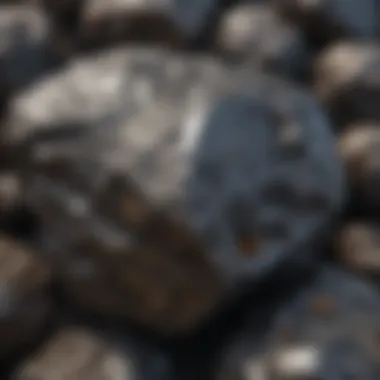
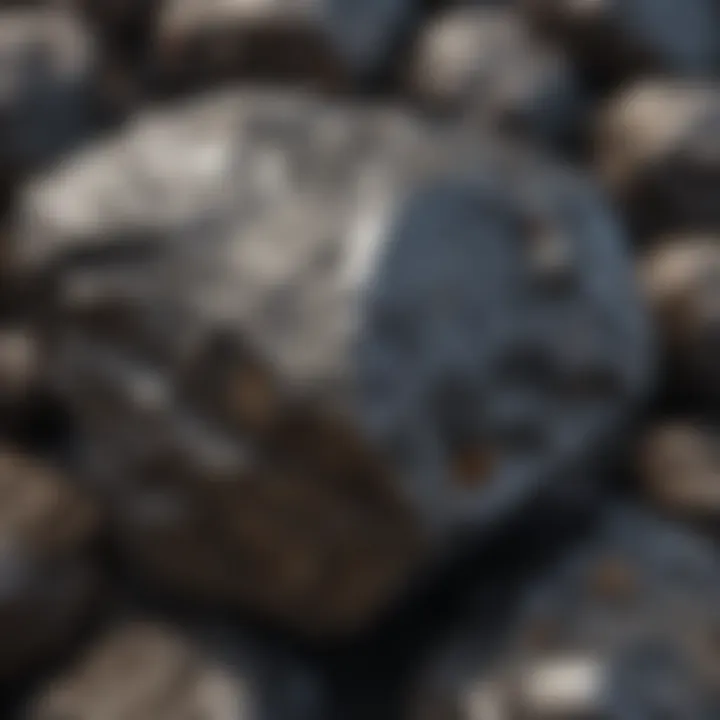
Intro
Meteorites have long captivated human interest, bridging the gap between our terrestrial home and the vast cosmos. These objects represent a unique fusion of materials from different worlds, each carrying a narrative that can span billions of years. Understanding their characteristics not only aids collectors but also honors the profound historical and scientific implications tied to their existence. This journey will explore both the distinguishing features and methods for identification, enriching your appreciation and maybe even sparking a new passion for these celestial fragments.
Featured Collectible of the Month
Overview
This month, we shine the spotlight on the Allende meteorite, an extraordinary specimen that fell in Mexico in 1969. The Allende meteorite is renowned for its rich content of chondrules and is classified as a carbonaceous chondrite, making it valuable for study due to its primitive composition, which preserves clues about the early solar system.
Historical Significance
The Allende meteorite holds a significant place in the annals of meteorite history. It was the first meteorite confirmed to contain organic compounds and amino acids, essential building blocks for life. Studying it has widened our understanding of the origins of life and the solar system itself, providing dimensions not merely to science but to the philosophical musings about our existence in the universe.
"Meteorites like the Allende teach us not only about the cosmos but also about ourselves."—Collector Insights
Identification Techniques
Visual Characteristics
Identifying meteorite rocks requires a keen eye for detail. Characteristics such as fusion crust, internal textures, and specific mineral types can shine a light on an object’s cosmic origin. Key visual features include:
- Fusion Crust: Smooth, dark outer layer formed when a meteorite passes through Earth’s atmosphere.
- Chondrules: Granules or blobs within the meteorite, generally seen in the more primitive types, often varying in color and size.
- Metallic Flakes: Presence of nickel-iron metal can signify a meteorite's authenticity.
A careful observation can reveal subtle differences that are pivotal in distinguishing meteorites from earth rocks or meteor-wrongs, as the latter can often mimic the real deal.
Resources for Identification
For those interested in identifying meteorites, a range of resources are available:
- Websites: Utilizing platforms like Wikipedia and Britannica can provide reliable foundational knowledge.
- Forums and Communities: Engaging with communities on Reddit can offer peer insights. Collectors often share their experiences and photographs, providing a wealth of informal knowledge.
- Books and Publications: Consider works specifically detailing meteorite studies, such as "Meteorites: A Petrologic, Chemical, and Physical Study" for in-depth academic exploration.
Enhancing your skills in identification not only boosts your confidence as a collector but also fosters a deeper connection with each specimen’s unique story.
As we move deeper into the characteristics of meteorites, it’s essential to understand not just what they are, but how to appreciate the narrative woven into their very existence.
Prologue to Meteorite Rocks
Meteorite rocks, those fascinating pieces of space debris that find their way to Earth, hold more than mere aesthetic value. For rock and fossil collectors, these celestial artifacts serve as tangible reminders of the solar system's history. Understanding their characteristics helps collectors, enthusiasts, and students alike appreciate not only the beauty but also the story behind each meteorite.
Definition of Meteorite Rocks
In straightforward terms, a meteorite is a solid fragment from a meteoroid that survives its fiery descent through Earth's atmosphere and lands on the surface. Meteoroids, typically space rocks, can originate from asteroids, the Moon, or even Mars. Once these pieces hit Earth, they capture the imagination of those keen on understanding planetary evolution. Meteorites come in various types, mainly classified as stony meteorites, iron meteorites, and stony-iron meteorites, each showcasing unique physical characteristics that can provide insight into their origins and previous journeys in the cosmos.
Importance in Scientific Research
The significance of meteorites extends far beyond mere curiosity. They provide invaluable data for scientists studying the formation of planets and the early solar system. By analyzing the chemical and isotopic compositions of meteorites, researchers can glean important information about the conditions present during the formation of our planet and its neighboring celestial bodies.
"Meteorites are like time capsules, preserving the history of the solar system in their mineral makeup."
Meteorites are not just relics; they often serve as a key to unlocking secrets of the universe. Their study can aid in understanding processes like planetary differentiation, which influences how bodies in space evolved. Furthermore, they contribute to our knowledge of water and organic compounds in the solar system, potentially shedding light on the origins of life on Earth. Themes involving planetary protection and future explorations to asteroids are incredibly relevant, making the study of meteorites not only fascinating but crucial for humanity’s future in space endeavors.
Physical Characteristics of Meteorite Rocks
Understanding the physical characteristics of meteorite rocks plays a vital role in their identification and classification. Each meteorite type possesses unique features that reflect their origin and formation processes. This section highlights the textures, colors, and densities that distinguish meteorites from terrestrial rocks. Collectors and enthusiasts greatly benefit from this knowledge as it enhances their ability to recognize and appreciate these celestial treasures.
Common Textures
Chondrites – Features and Structure
Chondrites are perhaps the most common type of meteorite found. They are characterized by their distinct spherical inclusions known as chondrules, which are grains of mineral that formed in the early solar system. The matrix surrounding these chondrules contains finer particles, giving chondrites a unique texture that resembles a speckled surface. This texture not only serves as a defining feature but also provides clues about the primitive materials present during the solar system's formation.
What makes chondrites particularly popular among collectors is their wide variety of types. For example, some chondrites are rich in olivine or pyroxene, while others may contain metallic inclusions. Their diversity and relatively abundant availability make chondrites appealing for those looking to enhance their collections. However, collectors should be aware that the presence of weathering can alter their appearance, leading to challenges in identification.
Achondrites – Variants and Identification
Achondrites, unlike chondrites, do not contain chondrules, which makes their appearance significantly different. They often resemble Earth rocks more closely due to their igneous origins. These meteorites typically originate from bodies like the Moon or Mars, and their structure can provide significant insights into the geological history of these celestial bodies.
A key feature of achondrites is their crystalline structure, which reflects the cooling rates and conditions under which they formed. This characteristic is a boon for researchers since it can help infer the thermal history of the parent body. While devoid of chondrules, their unique mineral compositions and textures make them integral to any meteorite collection, enhancing both aesthetic and educational value. However, the task of differentiating them from terrestrial rocks can be challenging for the untrained eye.
Iron Meteorites – Composition and Appearance
Iron meteorites, as the name suggests, are primarily composed of iron and nickel, which gives them distinctive metallic luster and a heavy weight. Their appearance is generally coarse and resembles a natural alloy. The structural uniqueness of iron meteorites arises from their crystalline patterns, often referred to as Widmanstätten patterns, which become visible when polished and etched.
These patterns are not just beautiful; they tell a story of the cooling processes that these meteorites underwent in the solar system. Iron meteorites are somewhat easier to identify due to their heavy density compared to stony meteorites. They form a smaller portion of meteorite finds but are particularly sought after due to their unique aesthetic and historical significance, allowing collectors to own a piece of the galactic narrative.
Color Variations
Typical Colors
The color of meteorite rocks is another characteristic that can aid in their identification. Meteorites can come in various shades, from dark browns and blacks to lighter shades like grey and green. Generally, stony meteorites are typically darker than iron meteorites. The specific color can give clues regarding the mineral composition and origin of the meteorite, with different types exhibiting different hues.
The vast color palette not only adds visual interest but also assists in the categorization process. Collectors appreciate the vivid differences, making color variations an attractive feature in any collection. However, it is important to note that weathering can alter the original colors, thus making it vital to consider the wider context of the meteorite's other features.
Oxidation Effects


Oxidation can significantly influence a meteorite's appearance, especially in iron-rich specimens. When exposed to moisture and air, iron meteorites can develop rust, altering their color and surface appearances. This change may pose challenges for identification, as the original characteristics may be masked by the oxidation layer.
While oxidation may detract from the aesthetic value of some meteorites, it can also serve as a vital key for understanding their environmental history. By studying the rate and nature of their oxidation, scientists can gather insights into the conditions faced by the meteorites post-landing and factors impacting them over time.
Density and Weight
Comparative Density to Earth Rocks
The density of a meteorite often serves as a crucial identifier. On average, meteorites are denser than typical Earth rocks. Iron meteorites, for example, can carry a density of around 7–8 g/cm³, whereas most terrestrial rocks are typically lower than this threshold.
This distinct density not only aids in identification but also provides insight into their composition. The knowledge of density can be particularly valuable to collectors who seek to understand and verify the authenticity of their specimens, as it can help distinguish meteorites from heavier terrestrial materials such as lead or certain ores.
Interpreting Weight in Identification
The weight of a meteorite is another key element in its identification. Generally, meteorites possess a heft that is unmistakable when compared to regular rocks. Collectors often take note of the weight per size ratio when evaluating specimens, as a significantly heavier piece may indicate it contains denser materials, like those found in iron meteorites.
This aspect of identification can be both an advantage and a challenge for collectors. While weight can provide a quick means of narrowing down possibilities, it can also be misleading. Some larger, low-density meteorites may weigh less than expected, complicating the identification process for newcomers in the field. Nonetheless, understanding the role of weight contributes to a holistic approach when assessing and identifying meteorites.
Classification of Meteorite Rocks
The classification of meteorite rocks is a cornerstone in understanding their diverse nature and origins. By organizing meteorites into distinct categories, researchers and collectors can better analyze their composition, track their history, and appreciate their uniqueness. This systematized approach is not just beneficial but essential for recognizing differing characteristics that aid in identification, scientific research, and the broader field of planetary science.
Stony Meteorites
Classification Schemes
Classification schemes for stony meteorites serve as a roadmap to their complex variety. The primary divisions often include chondrites and achondrites, each representing vital aspects of solar system history. Notably, chondrites, with their distinctive structures, are composed of small round particles called chondrules, making them particularly fascinating. This method is advantageous, as it allows collectors and researchers to quickly tap into categorization norms that offer insight into meteorite formation.
The classification of stony meteorites is not just beneficial; it is a popular subject among enthusiasts, as understanding these categories invites deeper exploration. By knowing how stony meteorites differ, scholars can better examine past geological events that have shaped our planet as well as others.
Identifying Features
Identifying features of stony meteorites, such as texture and mineral composition, play a vital role in their classification. For instance, chondrites often showcase a mix of minerals that hint at their parent body's history. Such variations contribute significantly to scientific analyses by providing clues regarding the early solar system.
The key characteristic of identifying features, with their focus on physical attributes, promotes consistency in meteorite study. Furthermore, the unique aspect of these features lies in their ability to cross-reference multiple specimens, making it easier for collectors to appreciate the distinctions. However, identifying features may not always portray the complete picture, as environmental factors can alter surface appearances.
Iron Meteorites
Typical Inclusives
Typical inclusives found in iron meteorites often reveal their origin in differentiated parent bodies. Comprised primarily of iron and nickel, these meteorites sometimes contain minerals such as troilite and graphite. The understanding of their inclusives enhances identification, allowing collectors to distinguish between types that may outwardly appear similar yet differ fundamentally in composition.
This focus on inclusives adds substantial value to meteorite studies by providing clues about the processes that led to their formation. It highlights their complexities, making iron meteorites a topic of ongoing interest for both collectors and scientists.
Formation Insights
Formation insights regarding iron meteorites provide context to their journey through space. They form from the molten cores of larger planetary bodies before being ejected into space, thus capturing a narrative of cosmic processes. This perspective enhances interest as it illustrates how these objects connect with a broader history regarding planetary formation.
The key aspect of these insights is that they educate collectors not merely to appreciate the form but to grasp the metamorphosis undergone by these meteorites throughout eons. Understanding their origins connects collectors to the universe—a fundamental aspect of meteorite enthusiasm.
Stony-Iron Meteorites
Distinctive Features
Distinctive features of stony-iron meteorites combine elements found in stony and iron meteorites, making them a unique classification. These meteorites often showcase a mix of metal and silicate minerals, leading to striking visual contrasts that captivate many collectors. Their appealing aesthetics, alongside their rarity, contribute to their desirability in collections.
These unique features not only heighten interest but also pose intriguing complexities during classification. Some enthusiasts may find them more challenging to identify due to overlapping attributes, yet this difficulty adds to the thrill of the hunt for both collectors and researchers.
Examples and Significance
The significance of stony-iron meteorites is found in notable examples such as the Gibeon and the Mount Piranha meteorites. Each offers a window into the processes that forge cosmic materials, and their rarity amplifies their value in scientific research and the collector’s market alike. Collectors seek them not just for their beauty but for the stories they carry about how elements come together in the universe.
Understanding these examples fosters a strong connection between the collector and the broader narrative of astrophysics, as they reflect both the nature of cosmic events and the character of human curiosity.
An accurate classification system is vital for meaningful understanding of meteorite origins, making it essential for both enthusiasts and experts alike.
Identifying Meteorite Rocks
Identifying meteorite rocks might seem a bit daunting at first glance, yet it is an essential practice both for enthusiasts and academics. Recognition of these extraterrestrial materials not only enhances our knowledge of the cosmos but also sheds light on the history of our planet. After all, meteorites are time capsules, offering a glimpse into processes that occurred during the formation of the solar system. For collectors, accurate identification can significantly influence value and authenticity, making the art of recognition all the more crucial.
In this section, we'll explore various techniques used to identify meteorite rocks, including simple field methods and comprehensive laboratory analyses. Both approaches have their unique merits and can be incredibly informative when used in tandem.
Field Identification Techniques
Field identification serves as the first line of recognition, allowing enthusiasts to spot meteorites amid earthly materials.
Use of Magnetism
Magnetism is one of the standout traits that can assist in identifying meteorite rocks. Many meteorites, particularly iron ones, contain significant amounts of nickel and iron, making them magnetic. By using a simple magnet, collectors can swiftly discern potential meteorite candidates.
The efficiency of magnetism lies in its accessibility; you don't need fancy equipment to test if a rock is magnetic. Small pocket magnets can usually do the trick. This field technique shines especially for those in outdoor environments, where time and resources might be limited.
However, it’s worth noting that some terrestrial rocks, like magnetite, can also be magnetic. This drawback means that while a positive magnetism test is promising, it is not definitive—by itself, it won’t confirm a rock as a meteorite.
Surface Features Examination
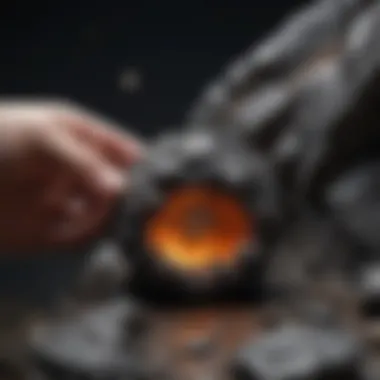
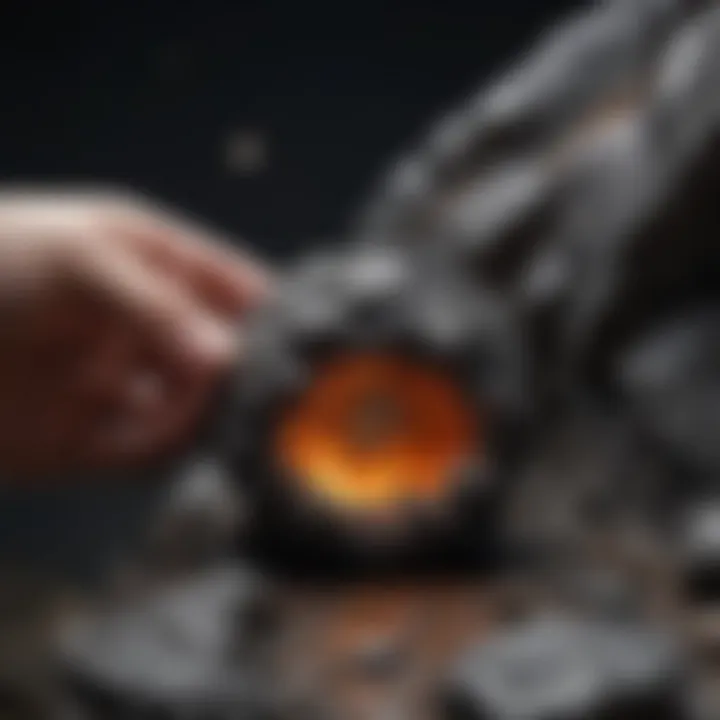
Surface features examination provides a closer look at the unique characteristics of meteorite rocks. Meteorites often display distinguishing surface markers such as thumbprints, which are formed during their fiery journey through the atmosphere. Observing these features can help differentiate meteorites from terrestrial counterparts.
One of the key advantages of this method is that it not only utilizes visual assessment but also engages other senses; closely looking at textures, and feeling the weight can offer clues too.
Nonetheless, this technique does have a downside. Identifying surface features requires careful and deliberate observation, and its reliability can be affected by the rock's condition. Weathering and geological processes on Earth can obscure important details, which makes it necessary to combine this approach with other identification methods for more conclusive results.
Laboratory Analysis
Once field methods have yielded possibilities, laboratory analysis can provide a more comprehensive understanding of meteorite rocks.
Thin Section Petrography
Thin section petrography is a sophisticated method that allows for detailed examination of meteorite composition. By slicing a meteorite into incredibly thin layers, scientists can use polarized light microscopy to observe mineral characteristics and their organization. Such analysis reveals insights about the rock's origin, age, and formation history.
This method stands out due to its ability to provide concrete biological data, which is irreplaceable for accurate identification. The detailed images obtained can uncover subtle features invisible to the naked eye, making it a popular choice among researchers.
The challenge, however, is accessibility. Thin section petrography requires specialized equipment and expertise, which might not be available to every collector or enthusiast.
Mass Spectrometry in Meteorite Studies
Mass spectrometry is another pivotal tool in the realm of meteorite identification. This analytical technique identifies elemental compositions by measuring the masses of particles. By understanding the isotopic makeup, researchers can trace the meteorite's origin and contribute to broader studies about the solar system.
What makes mass spectrometry particularly valuable is its precision. This method can identify even trace elements, providing a wealth of data about a meteorite's history.
On the flip side, the complexity and cost of mass spectrometry can make it prohibitive for casual collectors. It's typically used in research institutions rather than by individual enthusiasts.
Historical Context and Classification Systems
Understanding the historical context and classification systems of meteorite rocks adds depth to the study of these celestial specimens. The journey of meteorites from the cosmos to the Earth has not only fascinated scientists but has also influenced various fields of research, including geology, astronomy, and planetary science.
The narrative begins long ago, with early observations of bright streaks in the sky that led to the collection and categorization of fallen meteorites. This exploration provides insight into human curiosity about the universe. Recognizing these rocks wasn't merely an act of collecting; it symbolized the connection between ancient civilizations and the cosmos.
Moreover, classification systems have evolved significantly since those early days. Today’s complex categorization reflects advancements in technology, enhancing our understanding of meteorite composition and their origins. This evolution is crucial not just for collectors but for scientists aiming to piece together the puzzle of planetary formation and the history of our solar system.
From understanding historical narratives to implementing systematic classification, both elements contribute richly to the overall appreciation of meteorite rocks.
Historical Discoveries of Meteorites
Meteorites have sparked interest since ancient times, with some of the earliest known instances documented in the historical records of civilizations such as the Greeks and Chinese. For example, a notable event occurs in 1066 when a meteorite struck the Earth in a recorded meteor shower. Imagine the wonder and fear it generated among early witnesses!
- Famous Finds: One of the most significant meteorite discoveries was the Hoba meteorite in Namibia, which is the largest known iron meteorite and weighs around 60 tons. Its sheer size and unusual circumstances surrounding its discovery have made it an iconic example in the field.
- Impact Events: The Tunguska event in 1908 is another infamous incident, where a bright flash and a massive explosion occurred, believed to be caused by the airburst of a small comet or asteroid.
These historical discoveries play a crucial role in understanding how meteorites have been perceived and classified throughout the ages, influencing both scientific thought and cultural lore.
Meteorite Classification Evolution
As our understanding of meteorites has deepened, so has the necessity to classify them effectively. The initial, rough categorizations based on appearance have led to delineations grounded in scientific analysis.
Early systems tended to focus on visible characteristics: stony vs. iron vs. stony-iron meteorites. Nowadays, classification reflects a more systematic and empirical approach, influenced by the study of chemical composition and isotopic ratios. This shift allows for a more refined understanding of the origins and formation processes of these rare artifacts.
- Chondrites vs. Achondrites: One of the hallmark distinctions within stony meteorites is between chondrites—those containing round particles called chondrules—and achondrites, which are differentiated rocks similar to terrestrial igneous rocks. Understanding this classification can help in tracing the history of the solar system.
- Technological Advances: Techniques such as electron microprobe analysis and mass spectrometry have revolutionized how meteorites are classified. The ability to analyze trace elements enables a deeper understanding of their formation environments and subsequent evolution.
Meteorite Preservation and Care
Preserving meteorite rocks is not just a task; it's an art form that connects collectors with the cosmos. Proper preservation techniques safeguard these precious specimens from environmental factors that could diminish their value and integrity over time. Understanding how to care for meteorites is vital for ensuring their longevity and maintaining their scientific and aesthetic value.
Storage Recommendations
Climate Control Measures
Storing meteorites in an environment with controlled temperature and humidity is paramount. While many might not see the connection, fluctuations in climate can spell disaster for the fragile composition of these extraterrestrial wonders. Temperatures that swing too widely can lead to thermal expansion or contraction, causing fractures in the rock.
One essential aspect of climate control is maintaining a stable humidity level. High humidity can encourage rust formation, especially in iron meteorites. Using silica gel packets or desiccants in storage containers helps absorb excess moisture and keep humidity at bay.
A key characteristic of climate control measures is their proactive approach to preservation. By preventing potential harm before it occurs, collectors ensure the meteorites remain in their pristine state. This method is beneficial largely because it minimizes the need for later restorative work, which can sometimes be detrimental.
Advantages and Disadvantages
- Advantages:
- Disadvantages:
- Preserves the integrity of the meteorite
- Reduces risks of damage over time
- Can require initial investments in equipment or environment
Preventing Oxidation
Oxidation can be one of the most menacing threats to meteorite integrity, especially for those composed primarily of iron. Preventing this corrosive process is crucial for maintaining both the beauty and value of the specimen. The formation of rust not only alters the visual characteristics but can lead to drastic devaluation.
One effective preventive measure is the application of a protective wax or oil that can create a barrier against moisture and air. These coatings, however, should be applied carefully to ensure they do not obscure the meteorite’s details. The unique feature of preventing oxidation is that it speaks directly to the longevity of the collection itself.
Advantages and Disadvantages
- Advantages:
- Disadvantages:
- Effectively prolongs the life of iron meteorites
- Maintains visual appeal

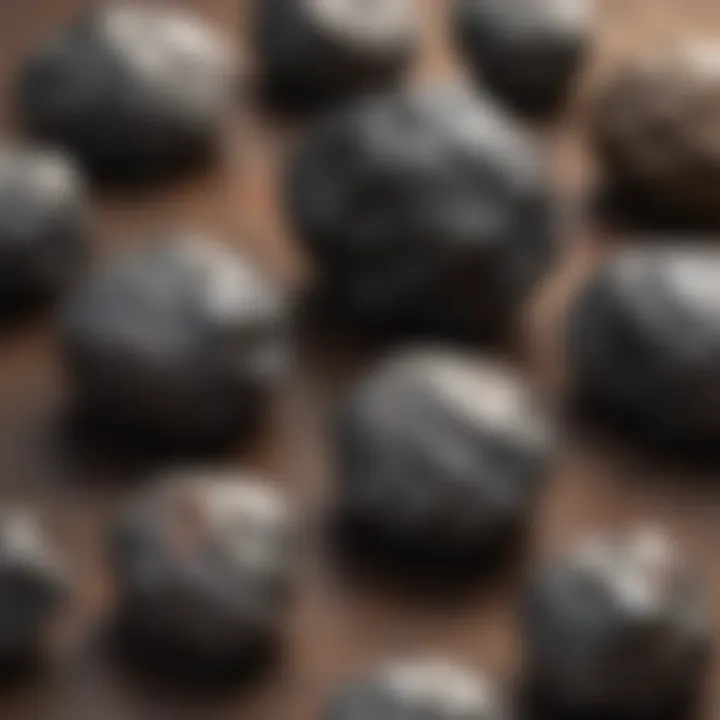
- Over-application can lead to buildup, which may obscure features
Cleaning Techniques
Safe Methods to Maintain Integrity
When it comes to cleaning meteorite specimens, gentleness is key. Many collectors recommend using a soft brush or a microfiber cloth to remove dust or debris. Using water or liquids should generally be avoided, as they may be absorbed by porous meteorites, causing irreparable harm.
One popular method is the dry brushing technique. This method ensures the removal of particles without compromising the rock's surface or its patina. The key characteristic here is the focus on low-impact cleaning methods, which is beneficial because it minimizes risks associated with abrasive cleaning.
Advantages and Disadvantages
- Advantages:
- Disadvantages:
- Maintains the meteorite's original characteristics
- A simple, inexpensive method
- May not remove more stubborn stains or residues
When to Avoid Cleaning
In some cases, it might be better to let well enough alone. Cleaning should be avoided if a meteorite shows traces of patina, surface coatings, or significant historical value. Removing these can diminish both its aesthetic charm and research potential.
The key characteristic of knowing when to avoid cleaning lies in an understanding of the meteorite’s history and value. Cleaning can sometimes erase the story told through its surface. Therefore, it’s vital for collectors to assess thoroughly before reaching for a brush.
Advantages and Disadvantages
- Advantages:
- Disadvantages:
- Preserves unique characteristics and history
- Avoids unintentional damage through inadequate cleaning methods
- Some dirt or grime may remain, which may not appeal to every collector
Understanding meteorite preservation is more than a checklist of dos and don'ts. It’s the key to connecting with the broader universe that these rocks represent. Through careful storage, cleaning, and an awareness of their significance, collectors not only protect their investments but also honor the journey of these stellar artifacts.
Significance of Meteorite Rocks in Collecting
Collecting meteorite rocks is not merely a hobby; it’s an exploration into the very foundations of our universe. Enthusiasts and collectors alike are drawn to meteorites due to their extraordinary origins, as each piece holds a story of cosmic travel and the history of our solar system. The significance of these celestial fragments extends beyond personal satisfaction. They serve numerous purposes in scientific research, education, and cultural exchange. Furthermore, the excitement of discovery paired with the potential for investment enhances the allure of meteorite collecting.
Value Assessment in Meteorite Collecting
Market Trends
The market trends in meteorite collecting have seen significant shifts over recent years. Interest has surged, drawing new collectors into a field traditionally dominated by a few seasoned enthusiasts. This growing demand has a direct effect on the value of certain types of meteorites. Unique finds, especially rare types like the Martian or Lunar meteorites, often fetch high prices at auctions. This scenario creates a unique market landscape where value can fluctuate wildly, depending on factors such as rarity, provenance, and aesthetic quality.
- Key Characteristics: The rarity and uniqueness of meteorites significantly drive their value, making certain specimens highly sought after.
- Benefits of Investments: Collectors may find that investing in meteorites can yield impressive returns, especially as the interest in space and celestial sciences grows.On the flip side, potential buyers should beware of overinflated prices or misleading information regarding quality and origin. Thus, proper research and knowledge are paramount for navigating these waters successfully.
Authenticity Verification
As the meteorite market expands, the importance of authenticity verification cannot be overstated. The rise in interest has unfortunately led to a proliferation of forgeries, making it essential for collectors to ensure they deal with genuine specimens. Authentic meteorites not only retain their value but also connect collectors to a piece of history.
- Key Characteristics: Techniques like isotopic analysis and petrological examination play crucial roles in establishing authenticity, providing evidence of a meteorite's extraterrestrial origins.
- Benefits of Authenticity: Validating a meteorite enhances not only its collectible value but also its integrity in the scientific community.However, the search for verification can be complicated. Sometimes, access to experts is limited, and the costs associated with testing can be a deterrent for new collectors. Therefore, it's important to build relationships with knowledgeable vendors and specialists in the field.
Community and Resources for Collectors
Building a network within the meteorite collecting community can be just as valuable as the specimens themselves. Connecting with other collectors and experts can provide insights, support, and opportunities for exchanging or acquiring pieces. Resources such as organizations and online platforms play an instrumental role in facilitating these connections.
Organizations and Societies
Meteorite collecting organizations and societies serve as a backbone for the community, providing vital resources for collectors. They often host events, lectures, and workshops that deepen knowledge about meteorites and enhance collecting skills.
- Key Characteristics: Most organizations provide members with access to expert advice, documentation, and materials to help verify the authenticity of meteorites.
- Benefits of Joining: Membership often includes newsletters, educational materials, and opportunities for networking.However, joining such organizations may come with membership fees and varying levels of commitment. Some newer collectors may find this needs evaluation against their current involvement level in the hobby.
Online Platforms and Forums
The digital age has revolutionized the way collectors connect and share knowledge. Online platforms and forums provide valuable spaces for discussion, selling, and trading meteorites. They democratize information, making it more accessible to anyone interested in the field.
- Key Characteristics: Popular platforms include Reddit threads and specialized Facebook groups that foster dialogue amongst aficionados.
- Benefits of Online Communities: These platforms allow for real-time communication, enabling collectors to ask questions, share experiences, and even showcase their collections.However, while online platforms are useful, they can also be risky due to misinformation and unverified claims. Collectors must exercise caution and discernment to ensure they gather correct, reliable information.
By engaging with both traditional organizations and modern online forums, meteorite collectors can enhance their understanding and enjoy the wonders the universe offers.
Epilogue
The conclusion serves as a pivotal chapter in understanding the vast landscape of meteorite rocks. It reiterates the significance of these celestial fragments, bringing together the threads woven throughout the article regarding their characteristics, classification, and identification techniques. By highlighting important elements such as the scientific insights gained from studying meteorites, we can appreciate their role in deciphering planetary formation and cosmic history.
Summary of Key Points
As we summarize the key points discussed, it is crucial to revisit the following elements:
- Physical Characteristics: Meteorites exhibit unique textures, colors, and densities that help in their classification. The distinction between chondrites, achondrites, and iron meteorites is fundamental for collectors.
- Identification Techniques: Knowing how to identify meteorites in the field and through laboratory methods elevates the collector's experience. Valuable techniques include using magnetism and analyzing surface features.
- Historical Importance: The historical context of meteorite discoveries illustrates how these rocks have shaped our understanding of the universe, revealing information about both past and present cosmic events.
- Collecting Significance: The meteoric rise in interest around meteorite collecting offers economic value, community engagement, and continuous learning opportunities for enthusiasts.
Reflecting on these points, we recognize that every meteorite rock tells a story, unveiling secrets from billions of years ago and shaping how we comprehend our place in the universe.
Future of Meteorite Studies
The future of meteorite studies promises to be as intriguing as the subjects themselves. With advancements in technology, researchers are now able to analyze samples with unprecedented accuracy. New instruments and methodologies in mass spectrometry and isotopic studies will likely reveal even more about the origins and chemical compositions of meteorites.
As educational platforms and resources become more accessible, more enthusiasts are entering the field. Online communities, such as those found on Reddit and Facebook, act as hubs for sharing findings, resources, and experiences among collectors. This growing community fosters collaboration and increases public interest in meteorite research and collecting.
The journey of meteorite studies appears to be heading towards greater inclusivity and interdisciplinary approaches, involving geology, astrochemistry, and planetary science. With these developments, we can expect a deeper understanding of not only meteorites but also the broader cosmic processes at play.
In summary, as collectors and researchers continue to advance their knowledge and techniques, the story of meteorite rocks will evolve, continually enriching our understanding and appreciation of these extraordinary fragments from beyond our world.



